Zebra Technologies LI3678 Linear Imager Scanner User Manual ET5X Enterprise Tablet Quick Reference Guide
Zebra Technologies Corporation Linear Imager Scanner ET5X Enterprise Tablet Quick Reference Guide
User Manual
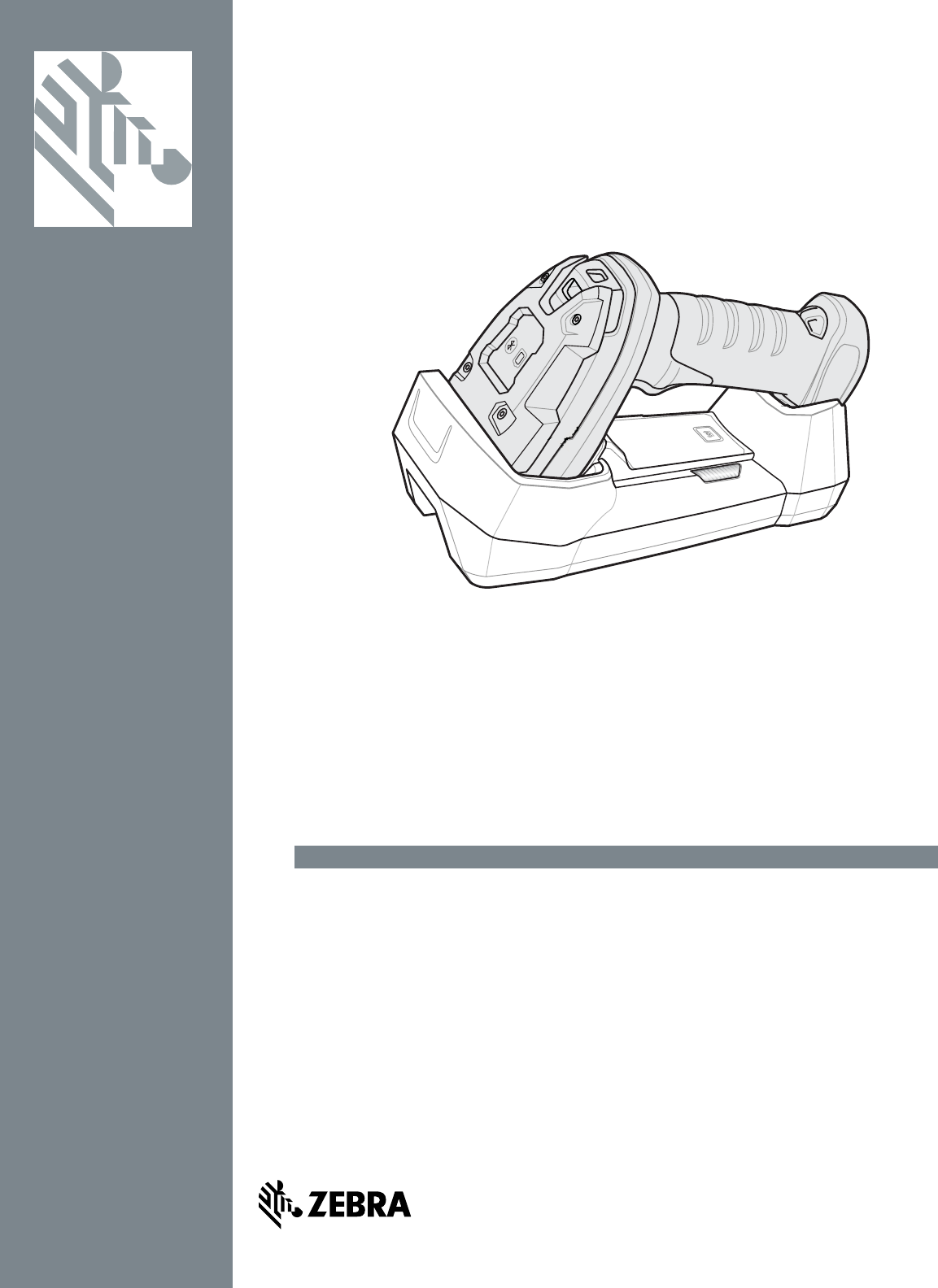
LI3678
Quick Start Guide
Linear Imager Scanner
Draft 1_Not for Distribution
2LI3678 Quick Start Guide
Zebra reserves the right to make changes to any product to improve reliability, function, or design.
Zebra does not assume any product liability arising out of, or in connection with, the application or use of any product,
circuit, or application described herein. No license is granted, either expressly or by implication, estoppel, or otherwise
under any patent right or patent, covering or relating to any combination, system, apparatus, machine, material,
method, or process in which Zebra products might be used. An implied license exists only for equipment, circuits, and
subsystems contained in Zebra products.
Warranty
For the complete Zebra hardware product warranty statement, go to: http://www.zebra.com/warranty.
For Australia Only
For Australia Only. This warranty is given by Zebra Technologies Asia Pacific Pte. Ltd., 71 Robinson Road, #05-02/03,
Singapore 068895, Singapore. Our goods come with guarantees that cannot be excluded under the Australia
Consumer Law. You are entitled to a replacement or refund for a major failure and compensation for any other
reasonably foreseeable loss or damage. You are also entitled to have the goods repaired or replaced if the goods fail to
be of acceptable quality and the failure does not amount to a major failure.
Zebra Technologies Corporation Australia’s limited warranty above is in addition to any rights and remedies you may
have under the Australian Consumer Law. If you have any queries, please call Zebra Technologies Corporation at +65
6858 0722. You may also visit our website: http://www.zebra.com for the most updated warranty terms.
Service Information
If you have a problem using the equipment, contact your facility’s Technical or Systems Support. If there is a problem
with the equipment, they will contact the Zebra Global Customer Support Center at: http://www.zebra.com/support.
For the latest version of this guide go to: http://www.zebra.com/support.
Draft 1_Not for Distribution
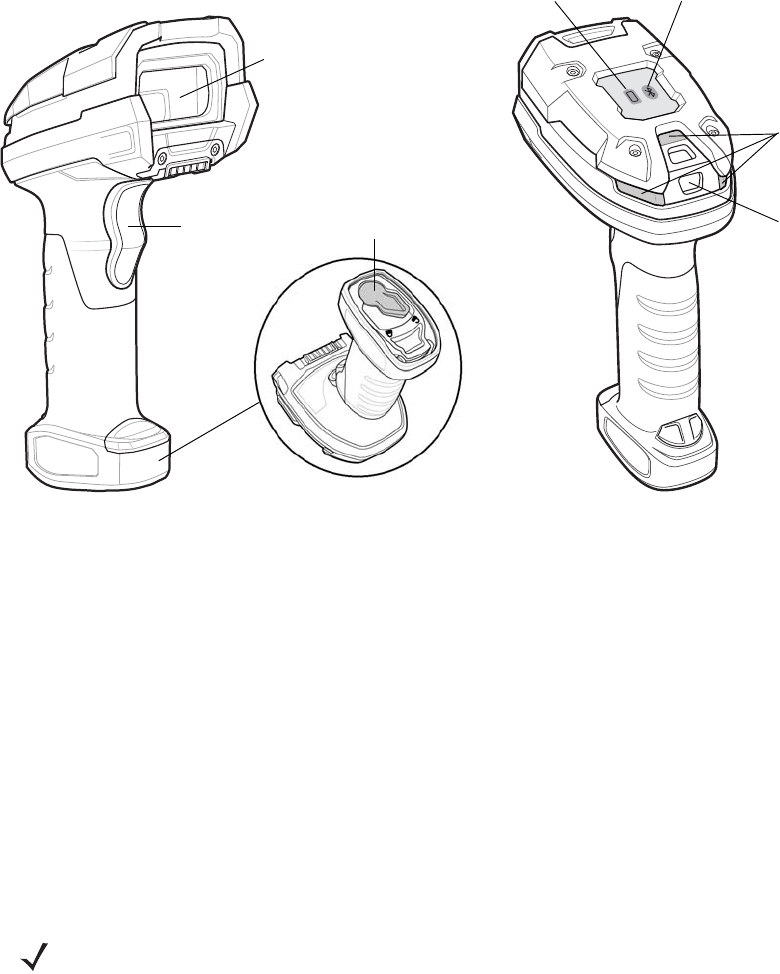
LI3678 Quick Start Guide 3
Introduction
The LI3678 linear imager combines excellent scanning performance and advanced ergonomics to provide the best
value in a lightweight laser scanner, ensuring comfort and ease of use for extended periods of time.
Features
Cradle
The cradles serve as a charger, radio communication interface, and host communication interface for the LI3678
cordless linear imager scanner. There are two versions of the cradle:
•
The STB3678 cordless cradle sits on a desktop or mounts on a wall, and charges the LI3678 cordless linear
imager scanner. This cradle also provides host communication by receiving scanner data via a Bluetooth radio,
and sending that data to the host through an attached cable. An external power supply or a powered host cable
charges the linear imager scanner.
•
The FLB3678 cordless cradle charges the LI3678 cordless linear imager scanner, and provides host
communication by receiving scanner data via a Bluetooth radio, and sending that data to the host through an
attached cable. The cradle attaches to a mounting bracket using three isolators, and the bracket then mounts on
the forklift surface. A portable power supply on the forklift provides power to the cradle.
DO NOT use cradles and cables designed for the LS3578 and DS3578 scanners as they are not compatible with the
LI3678 linear imager scanner.
For more information about mounting options and procedures, refer to the documentation included with the cradle.
NOTE For more information about communication between the linear imager scanner, cradle, and host, see
Chapter 4, Radio Communications.
Beeper
LEDs
Trigger
Scan Window
Battery LED Radio LED
Battery Latch
Draft 1_Not for Distribution
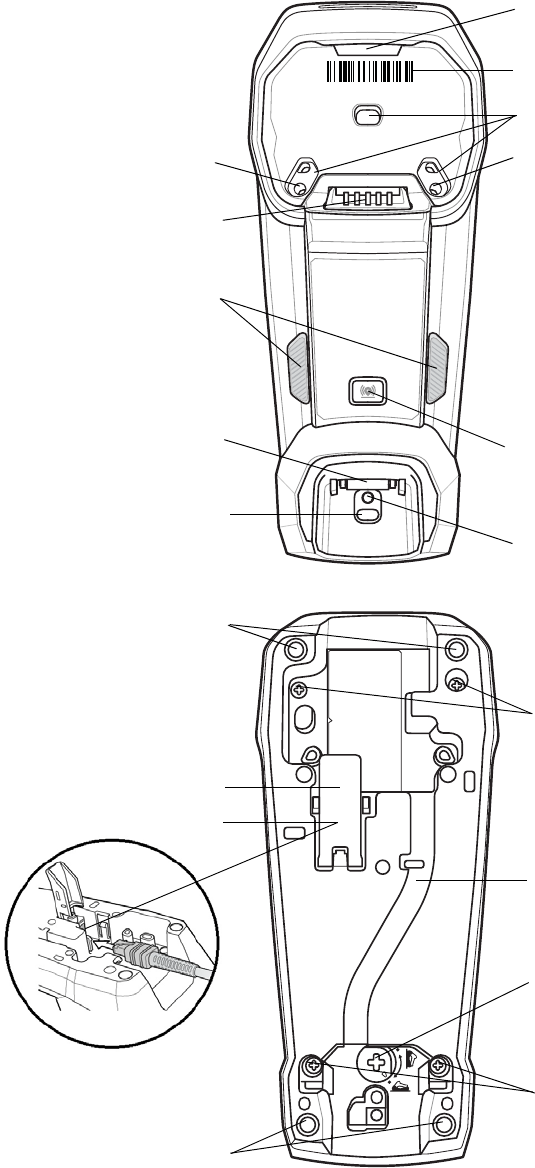
4LI3678 Quick Start Guide
Cradle Parts
Figure 1-1
Cradle Front View
Figure 1-2
Cradle Back ViewConnecting the Cradle
Charging/
Communications
Contacts
Pairing
Bar Code
Mounting
Screw Hole
Foot Latch
LED
Mounting
Screw Hole
PAIR
Drain Hole
Canopy Latch
Mounting
Screw Hole
Page Button
Drain Hole
Rubber Feet
Host Cable Guide
Foot Latch Release
Mounting Screw Hole
Mounting Screw Hole
Host Cable Latch
Host Cable (Under Latch)
Rubber Feet
Draft 1_Not for Distribution
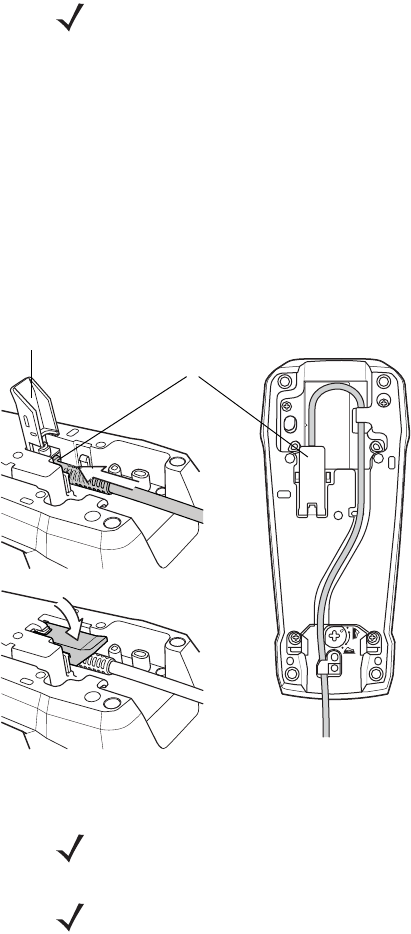
LI3678 Quick Start Guide 5
Connecting STB3678/FLB3678 Cradles
1. Connect the appropriate cable to the power supply and an AC power source, if necessary.
2. Insert the interface cable into the host port.
3. Lift the latch and connect the interface cable into the cradle's host port and then close the latch. See
Figure 1-3.
4. If applicable, thread the interface cable over the cable support hook and run the host and power cables into the
respective cable grooves.
5. Pair the linear imager scanner to the cradle either by inserting it in the cradle (if pair on contacts is enabled), or by
scanning the pairing bar code.
6. If necessary, scan the appropriate host bar code (for non-autodetected interfaces). See the specific host chapter.
Figure 1-3
Connecting the Cables to the Cradle
NOTE Connect the interface cable and power supply (if necessary) in the following order to ensure proper
operation of the linear imager scanner and cradle.
NOTE Always disconnect the DC power supply BEFORE disconnecting the cable to the host end or the cradle
may not recognize the new host.
NOTE Different cables are required for different hosts. The connectors illustrated in each host chapter are
examples only. The connectors may be different from those illustrated, but the steps to connect the linear
imager scanner remain the same.
Host Port
Latch
(Under Latch)
Draft 1_Not for Distribution

6LI3678 Quick Start Guide
Supplying Power to the Cradle
The cradle receives power from one of two sources:
•
An external power supply.
•
When connected to the host through an interface cable that supplies power.
The cradle detects whether the host or the external supply is supplying power. It always draws power from the external
supply when available, regardless of the presence of power from a host.
Mounting the Cradle
For information on mounting the cradle, refer to the documentation included with the cradle.
NOTE Supplying power from a USB host may take longer to charge the linear imager scanner.
Draft 1_Not for Distribution
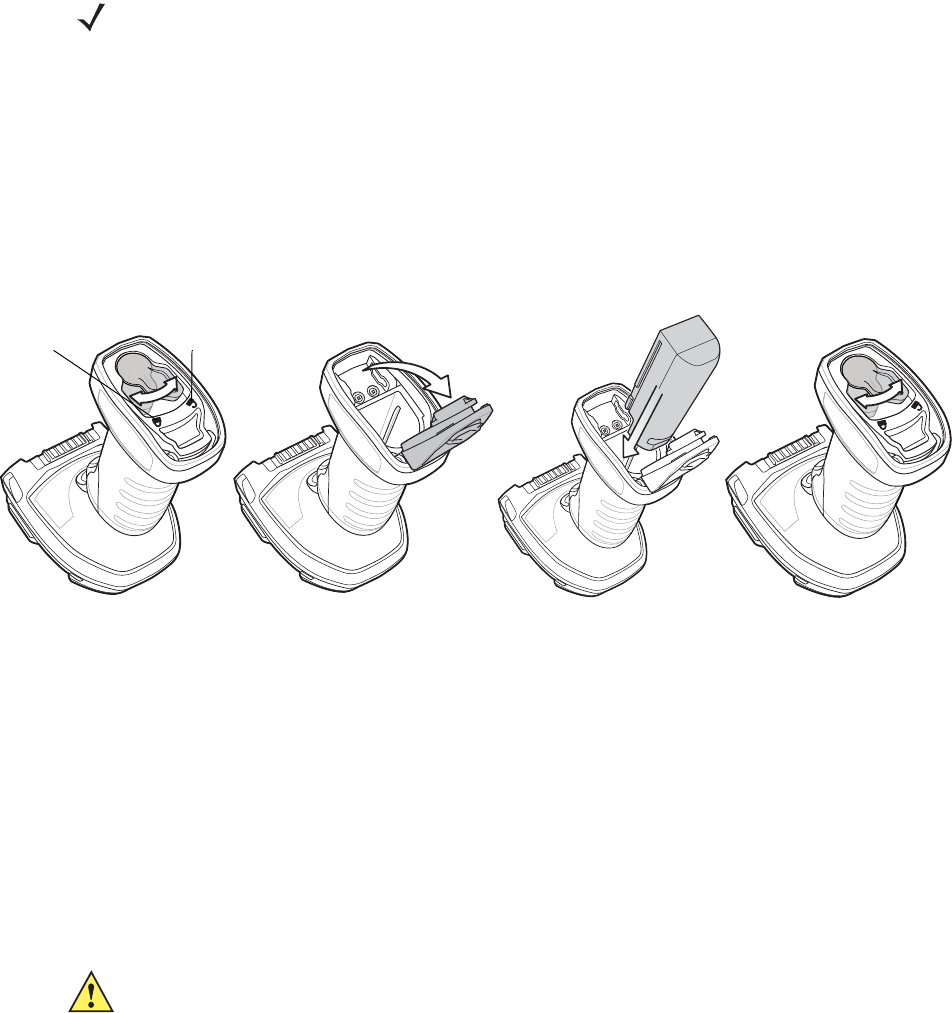
LI3678 Quick Start Guide 7
Inserting the Battery
The battery resides in a chamber in the linear imager scanner handle. To insert the battery:
1. Lightly press down and slide the locking lever counterclockwise to unlock and release the battery door.
2. Open the battery door.
3. If a battery is already installed, turn the linear imager scanner upright to slide the battery out.
4. Slide the new battery into the chamber, with the rounded side toward the back and the contacts facing into the
chamber.
Figure 1-4
Inserting the Battery (Add Illustration)
5. Close the battery door.
6. Lightly press down and slide the locking lever clockwise to lock the battery door.
7. If using a brand new battery, insert the scanner into a cradle to turn the battery on.
Removing the Battery
To remove the battery:
1. Lightly press down and slide the locking lever counterclockwise to unlock the battery door.
2. Open the battery door.
3. Turn the linear imager scanner upright to slide the battery out.
Charging the LI3678 Battery
When using a new battery in the LI3678, the battery requires a charge to be enabled. Insert the battery (see Inserting
the Battery on page 7) in the LI3678 and place the LI3678 in the STB/FLB3678 cradle (see Inserting the Scanner in the
Cradle on page 8).
The battery begins charging when the cradle’s LED indicator starts blinking amber. The LI3678’s battery has completed
a charge when the cradle’s LED indicator is solid green. A complete charge of a fully discharged battery can take up to
three hours using external power and up to ten hours using USB power over the USB interface cable.
See Beeper and LED Definitions on page 1 for detailed LED indicator information.
NOTE Batteries are shipped in an Off mode and does not power the scanner. After inserting a new
battery into the LI3678 linear imager scanner, you must insert the scanner into a cradle for the
battery to turn On.
Alternatively, the battery can be placed in the four slot spare battery charger to charge and then
inserted in the scanner for immediate use.
CAUTION To avoid a battery temperature fault, always charge the battery in the linear imager scanner within the
recommended temperature of
32° to 104° F (0° to 40° C) nominal, 41° to 95° F (5° to 35° C) ideal
.
Unlock
Lock
Draft 1_Not for Distribution
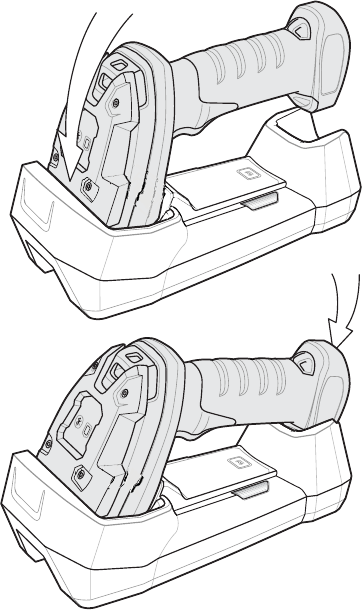
8LI3678 Quick Start Guide
Inserting the Scanner in the Cradle
To insert the linear imager scanner in the cradle:
1. Insert the linear imager scanner into the cradle top first.
2. Push the handle until it clicks into place, engaging the contacts in the cradle and linear imager scanner.
Figure 1-5
Inserting the Scanner in the Cradle
Draft 1_Not for Distribution

LI3678 Quick Start Guide 9
Sending Data to the Host Computer
The cradle receives data from the linear imager scanner via a wireless radio connection and transmits it to the host
computer via the host cable. The linear imager scanner and cradle must be paired for successful wireless
communication.
Pairing
Pairing registers a scanner to the cradle such that the scanner and cradle can exchange information. The STB3678
and FLB3678 operate in two modes: Point-to-Point and Multipoint-to-Point. In Point-to-Point mode, pair the linear
imager scanner to the cradle either by inserting it in the cradle (if pair on contacts is enabled), or by scanning the
pairing bar code. In Multipoint-to-Point mode, you can pair up to seven scanners to one cradle. To use this feature,
scan the multipoint bar code in Multipoint-to-Point Communication on page 19.
To pair the linear imager scanner with the cradle, scan a pairing bar code. A high-low-high-low beep sequence followed
by a low-high beep sequence indicates successful pairing and connection to the remote device. A long low, long high
beep sequence indicates unsuccessful pairing.
Lost Connection to Host
If scanned data does not transmit to the cradle's host, ensure that all cables are firmly inserted and the power supply is
connected to an appropriate AC outlet, if applicable. If scanned data still does not transmit to the host, reestablish a
connection with the host:
1. Disconnect the power supply from the cradle.
2. Disconnect the host interface cable from the cradle.
3. Wait three seconds.
4. Reconnect the host interface cable to the cradle.
5. Reconnect the power supply to the cradle, if the host requires.
6. Reestablish pairing with the cradle by scanning the pairing bar code.
Configuring the Scanner
Use the bar codes in this manual or the 123Scan2 configuration program to configure the linear imager scanner. See
Chapter 5, User Preferences and each host chapter for information about programming the linear imager scanner
using bar code menus. See Chapter 11, 123Scan2 to configure the linear imager scanner using this configuration
program. 123Scan2 includes a help file.
Radio Communications
The linear imager scanner can communicate with remote devices via Bluetooth, or by pairing with a cradle. For radio
communication parameters, detailed information about operational modes, Bluetooth and pairing, see Chapter 4,
Radio Communications.
NOTE The pairing bar code that connects the linear imager scanner to a cradle is unique to each cradle.
Do not scan data or parameters until pairing completes.
Draft 1_Not for Distribution
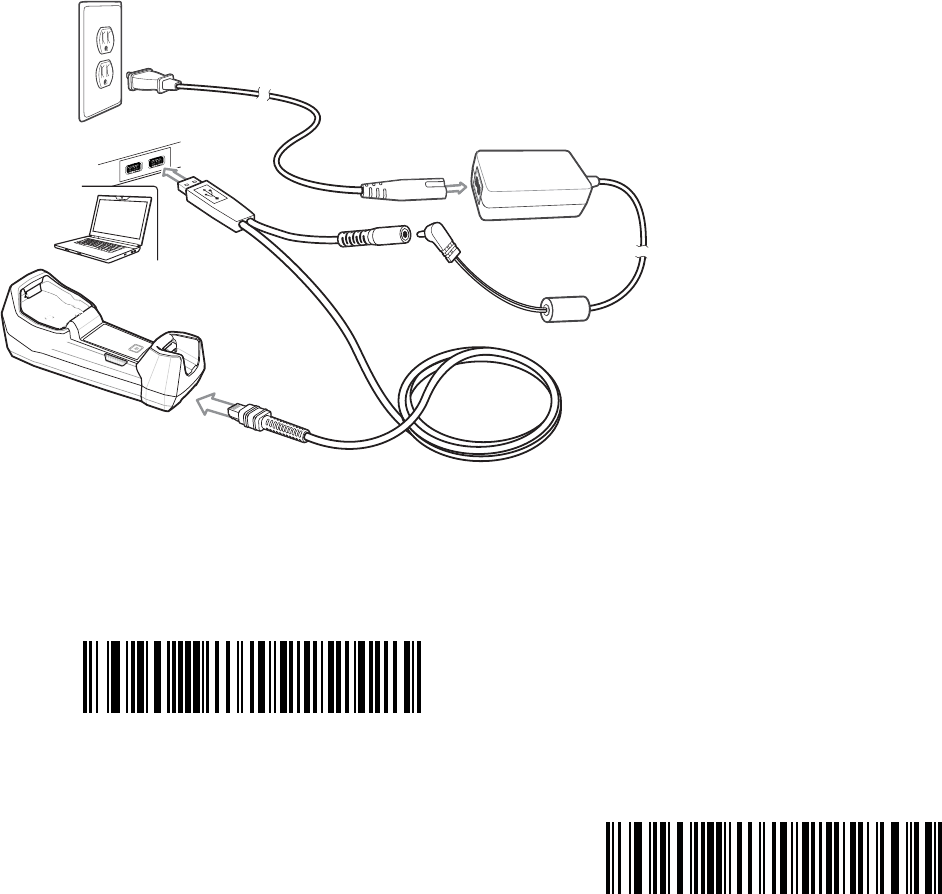
10 LI3678 Quick Start Guide
Connect Host Interface
USB
The digital scanner automatically detects the host interface type and uses the default setting. If the default (*) does not
meet your requirements, scan another host bar code below.
*USB KEYBOARD (HID)
USB CDC HOST
Draft 1_Not for Distribution
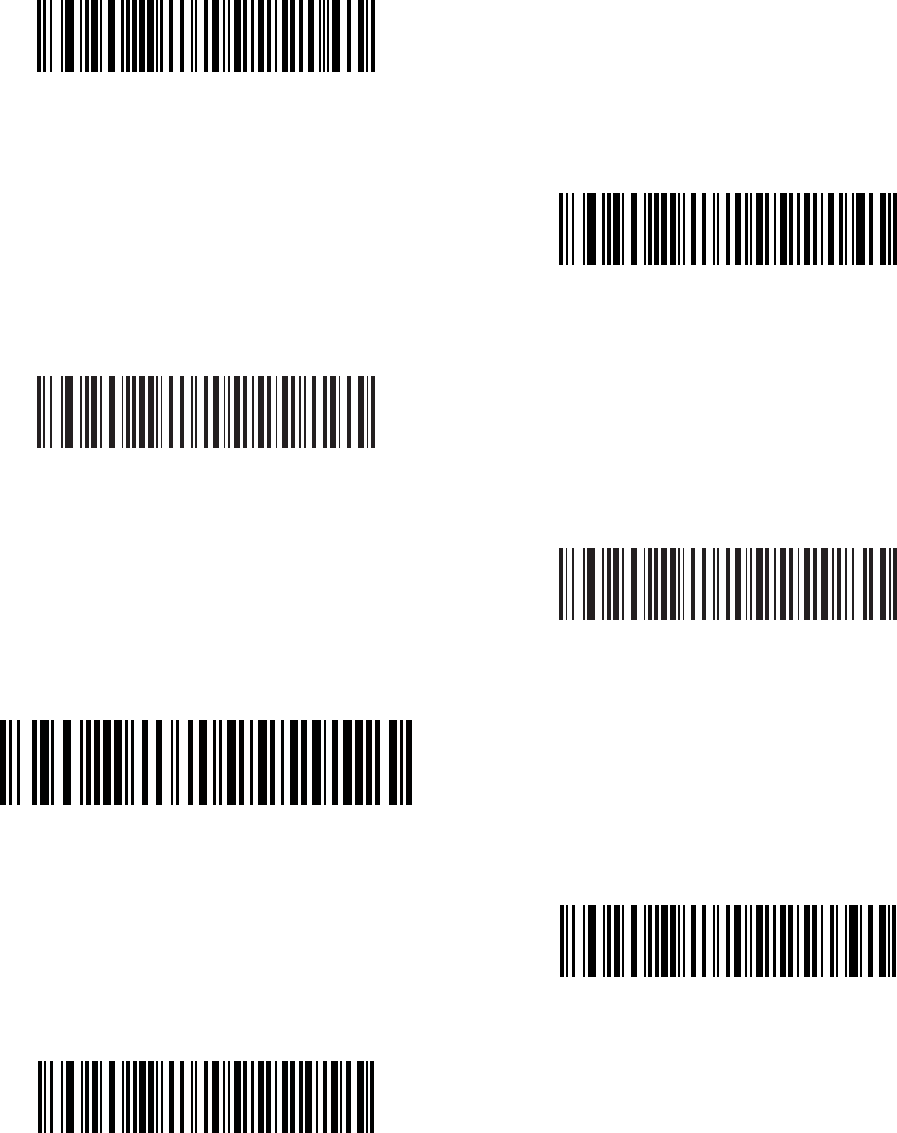
LI3678 Quick Start Guide 11
USB (continued)
IBM TABLE TOP USB
IBM HAND-HELD USB
SNAPI WITHOUT IMAGING
SNAPI WITH IMAGING
USB OPOS HAND-HELD
SSI OVER USB CDC
SIMPLE COM PORT EMULATION
Draft 1_Not for Distribution
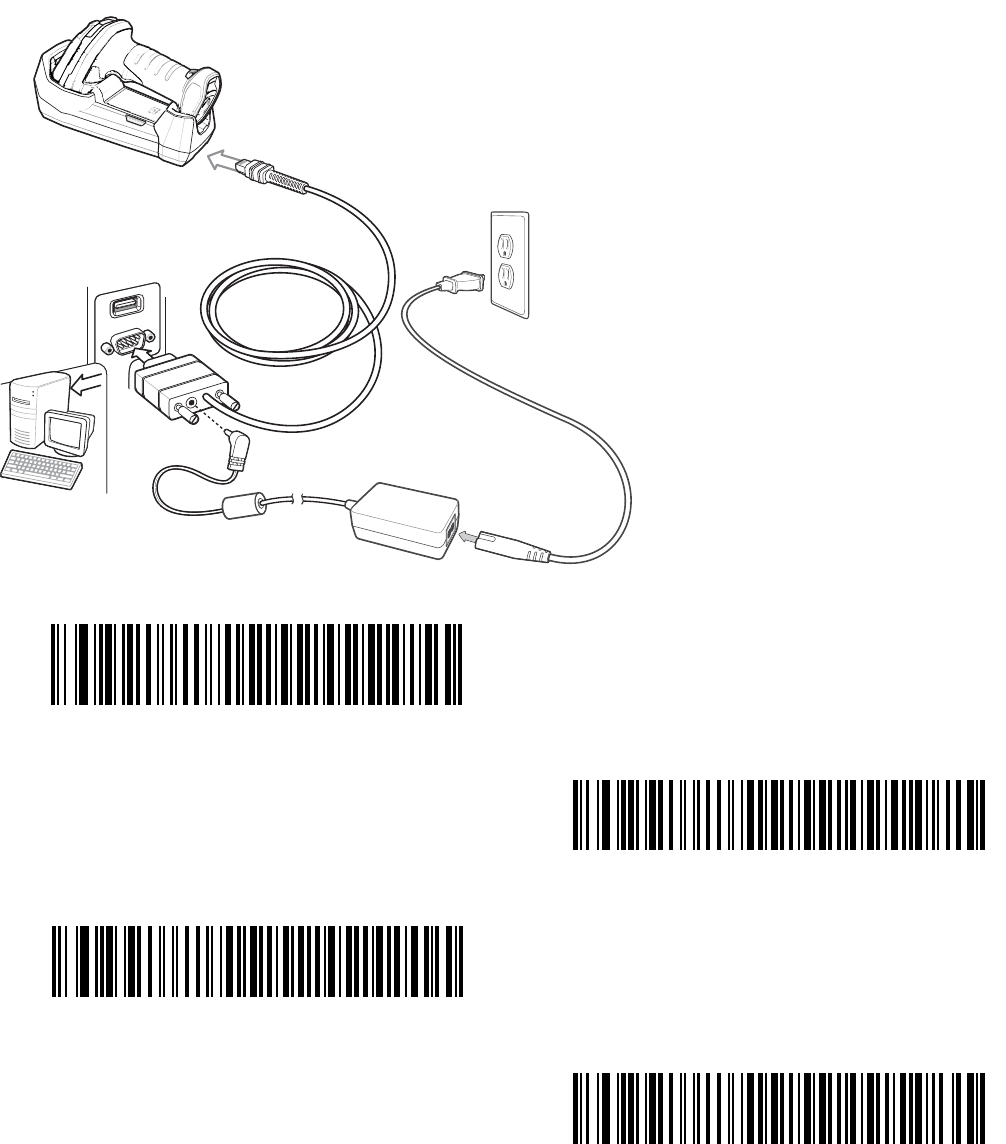
12 LI3678 Quick Start Guide
RS-232
*STANDARD RS-232
ICL RS-232
NIXDORF RS-232 MODE A
NIXDORF RS-232 MODE B
Draft 1_Not for Distribution
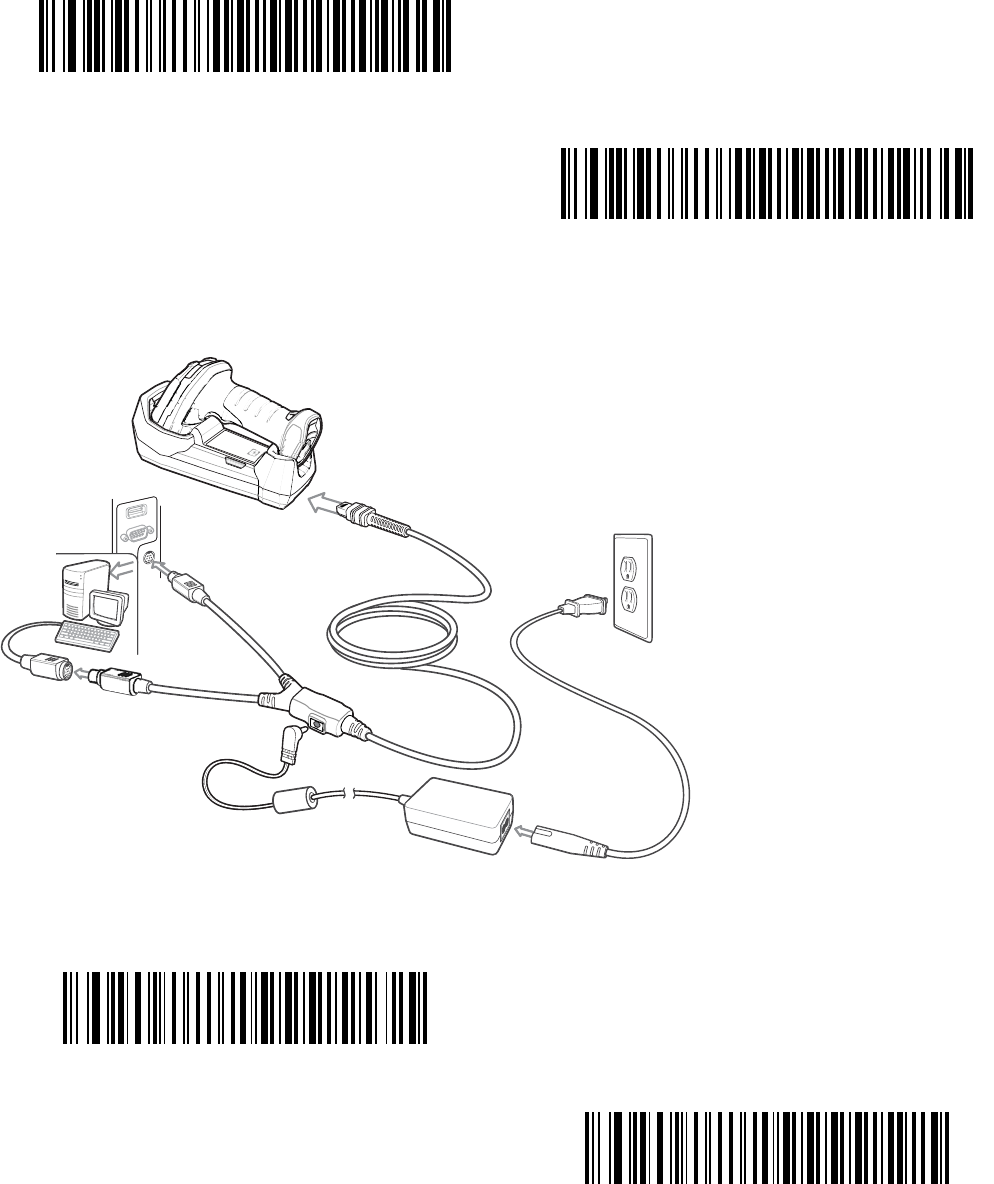
LI3678 Quick Start Guide 13
RS-232 (continued)
Keyboard Wedge
FUJITSU RS-232
OPOS/JPOS
*IBM AT NOTEBOOK
IBM PC/AT and IBM PC COMPATIBLE
Draft 1_Not for Distribution
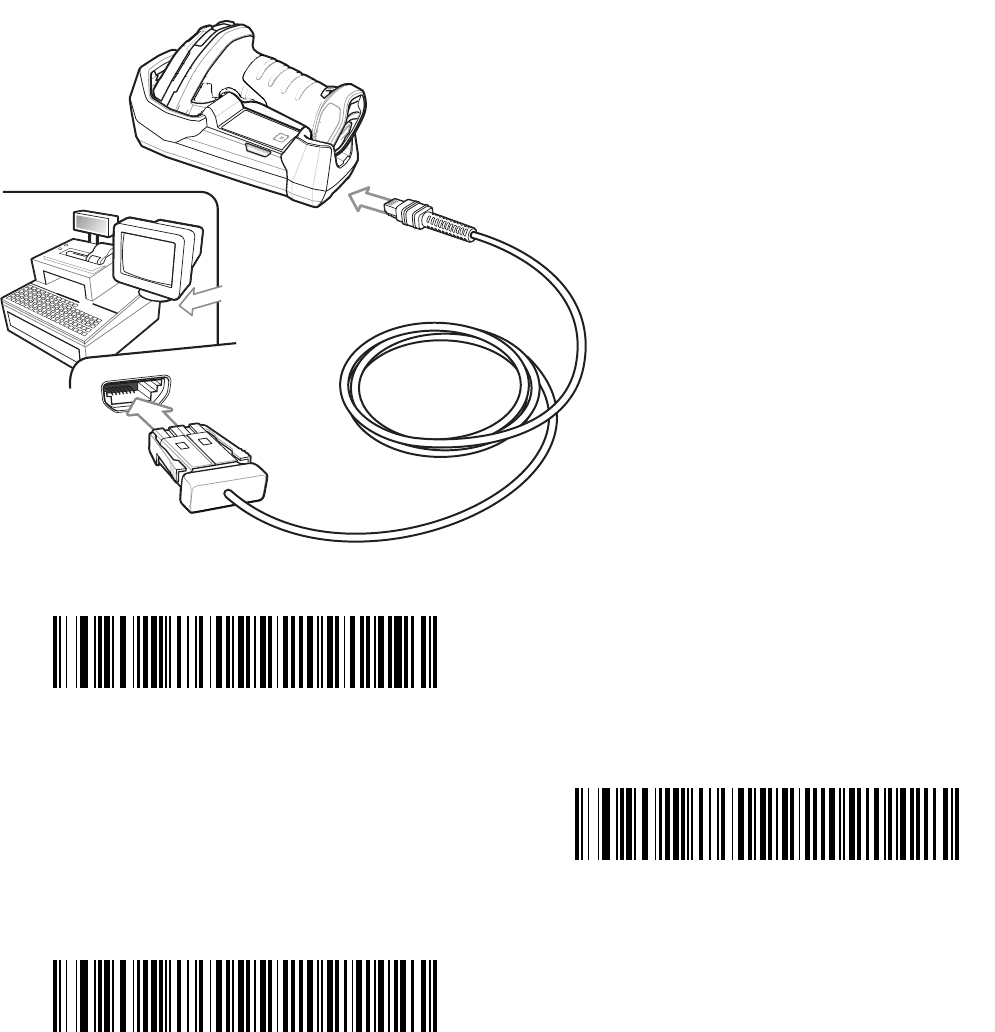
14 LI3678 Quick Start Guide
IBM 46XX
NON-IBM SCANNER EMULATION (PORT 5B)
HAND-HELD SCANNER EMULATION (PORT 9B)
TABLE-TOP SCANNER EMULATION (PORT 17)
Draft 1_Not for Distribution
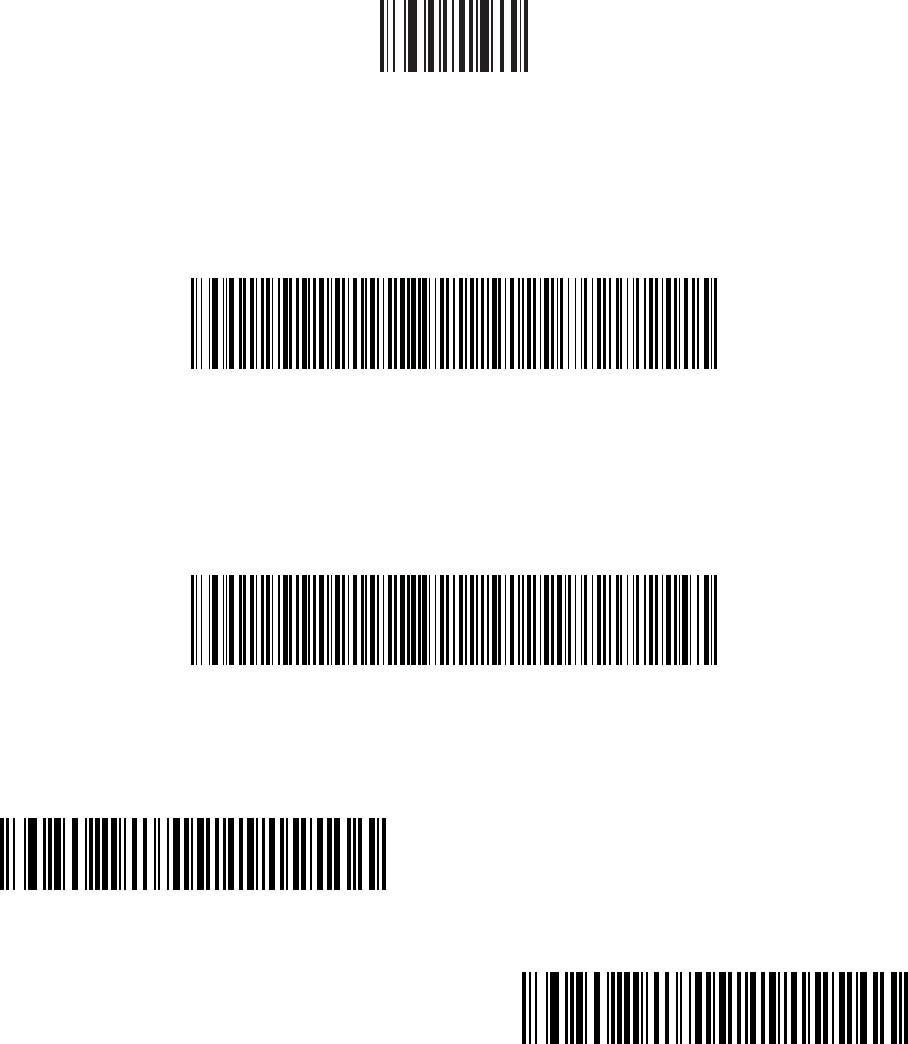
LI3678 Quick Start Guide 15
Set Defaults Bar Code
RETURN TO FACTORY DEFAULTS
Enter Key Bar Code (Carriage Return/Line Feed)
Add an Enter key after scanned data.
ADD AN ENTER KEY (CARRIAGE RETURN/LINE FEED)
Tab Key Bar Code
Add a Tab key after scanned data.
ADD A TAB KEY
USB Caps Lock Override
USB - OVERRIDE CAPS LOCK KEY (ENABLE)
*USB - DO NOT OVERRIDE CAPS LOCK KEY (DISABLE)
Draft 1_Not for Distribution
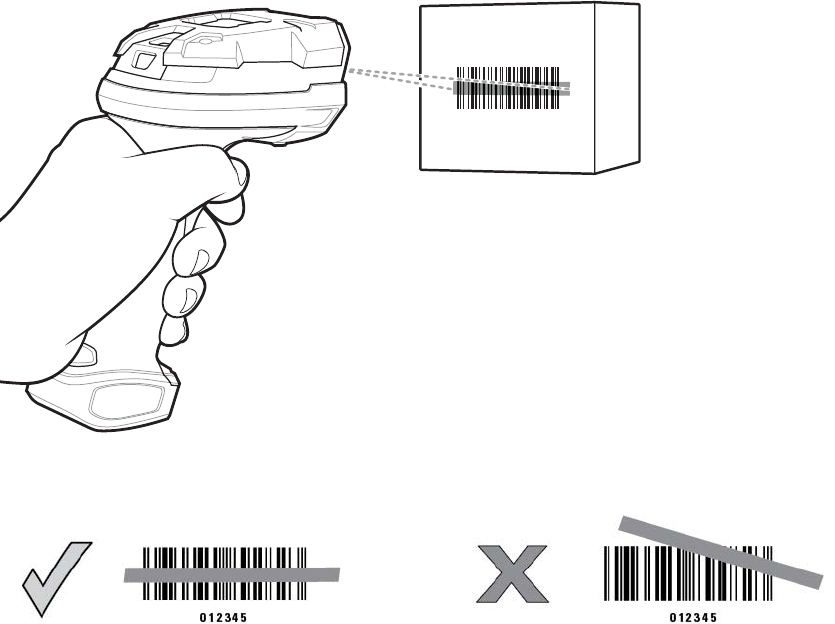
16 LI3678 Quick Start Guide
Scanning
Aiming
Draft 1_Not for Distribution
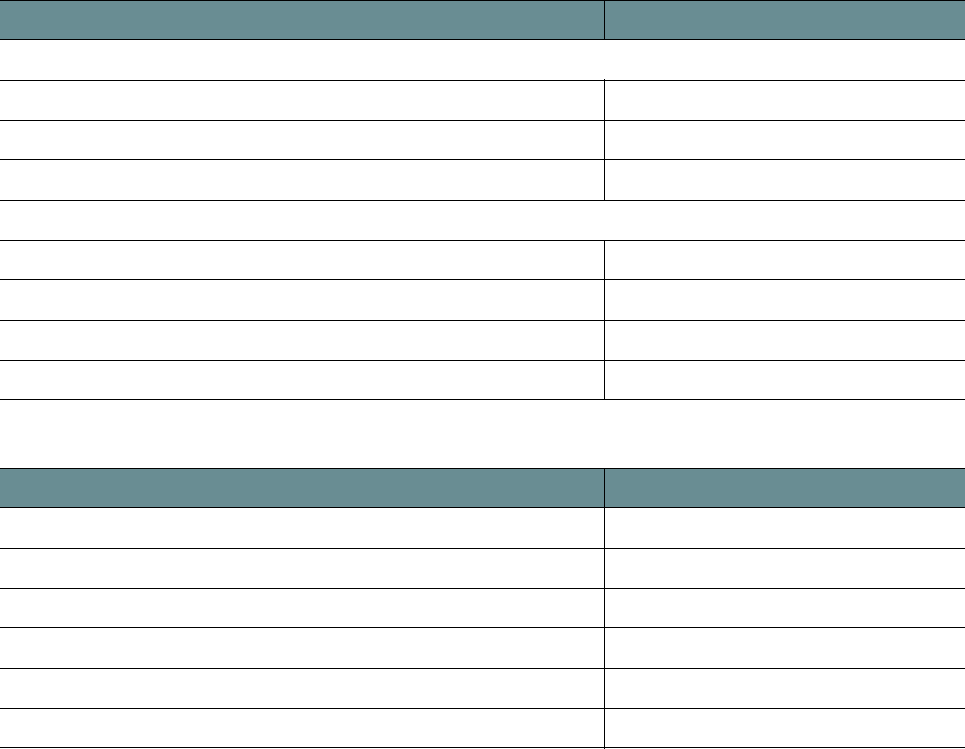
LI3678 Quick Start Guide 17
LED Indications
Beeper Indications
Indication LED
Hand-Held Scanning
The scanner is on and ready to scan, or no power to the scanner Off
A bar code is successfully decoded Green
Transmission error Red
Hand-Free (Presentation) Scanning
No power to the scanner Off
The scanner is on and ready to scan Green
A bar code is successfully decoded Off momentarily
Transmission error Red
Indication Beeper Sequence
Power up Low/medium/high beep
A bar code is successfully decoded Medium beep
Transmission error detected; data is ignored 4 long low beeps
Successful parameter setting High/low/high/low beep
Correct programming sequence performed High/low beep
Incorrect programming sequence, or
Cancel
bar code scanned Low/high beep
Draft 1_Not for Distribution

18 LI3678 Quick Start Guide
Regulatory Information
For devices with Symbol, or Symbol Technologies Inc., etc. on the Manufacturing Label and for devices manufactured
at Reynosa, or any other Zebra factory facilities:
This device is approved under Zebra Technologies Corporation.
This guide applies to Model Number: LI3678. All Zebra devices are designed to be compliant with rules and regulations
in locations they are sold and will be labeled as required. Local language translations are available at the following
website: http://www.zebra.com/support.
Any changes or modifications to Zebra equipment, not expressly approved by Zebra, could void the user’s authority to
operate the equipment.
Bluetooth® Wireless Technology
This is an approved Bluetooth® product. For more information or to view the End Product Listing, please visit
https://www.bluetooth.org/tpg/listings.cfm.
Wireless Device Country Approvals
Regulatory markings subject to certification are applied to the device signifying the radio(s) is/are approved for use in
the following countries and continents: United States, Canada, Japan, China, South Korea, Australia, and Europe.
Please refer to the Declaration of Conformity (DoC) for details of other country markings. This is available at:
http://www.zebra.com/doc.
Note: Europe includes Austria, Belgium, Bulgaria, Croatia, Czech Republic, Cyprus, Denmark, Estonia, Finland,
France, Germany, Greece, Hungary, Iceland, Ireland, Italy, Latvia, Liechtenstein, Lithuania, Luxembourg, Malta,
Netherlands, Norway, Poland, Portugal, Romania, Slovak Republic, Slovenia, Spain, Sweden, Switzerland, and the
United Kingdom.
Health and Safety Recommendations
Ergonomic Recommendations
•
Reduce or eliminate repetitive motion
•
Maintain a natural position
•
Reduce or eliminate excessive force
•
Keep objects that are used frequently within easy reach
•
Perform tasks at correct heights
•
Reduce or eliminate vibration
•
Reduce or eliminate direct pressure
•
Provide adjustable workstations
•
Provide adequate clearance
•
Provide a suitable working environment
•
Improve work procedures.
CAUTION Only use Zebra approved and UL Listed accessories, battery packs, and battery chargers.
Do NOT attempt to charge damp/wet mobile computers or batteries. All components must
be dry before connecting to an external power source.
Declared maximum operating temperature: 50°C.
NOTE This section is only applicable to WW/WR/EU configurations.
CAUTION Operation of the device without regulatory approval is illegal.
CAUTION In order to avoid or minimize the potential risk of ergonomic injury follow the recommendations below.
Consult with your local Health & Safety Manager to ensure that you are adhering to your company's
safety programs to prevent employee injury.
Draft 1_Not for Distribution

LI3678 Quick Start Guide 19
Warnings for Use of Wireless Devices
Safety in Hospitals
Wireless devices transmit radio frequency energy and may affect medical electrical equipment.
Wireless devices should be switched off wherever you are requested to do so in hospitals, clinics or healthcare
facilities. These requests are designed to prevent possible interference with sensitive medical equipment.
Pacemakers
Pacemaker manufacturers recommended that a minimum of 15cm (6 inches) be maintained between a hand-held
wireless device and a pacemaker to avoid potential interference with the pacemaker. These recommendations are
consistent with independent research and recommendations by Wireless Technology Research.
Persons with Pacemakers:
• Should ALWAYS keep the device more than 15cm (6 inches) from their pacemaker when turned ON.
• Should not carry the device in a breast pocket.
• Should use the ear furthest from the pacemaker to minimize the potential for interference.
• If you have any reason to suspect that interference is taking place, turn OFF your device.
Other Medical Devices
Please consult your physician or the manufacturer of the medical device, to determine if the operation of your wireless
product may interfere with the medical device.
RF Exposure Guidelines
Safety Information
•Reducing RF Exposure – Use Properly
Only operate the device in accordance with the instructions supplied.
• International
The device complies with internationally recognized standards covering human exposure to electromagnetic fields
from radio devices. For information on “International” human exposure to electromagnetic fields refer to the Zebra
Declaration of Conformity (DoC) at http:www.zebra.com/doc.
For further information on the safety of RF energy from wireless devices, see
http://responsibility.zebra.com/index.php/downloads/, which is located under Wireless Communications and Health.
•Europe
•Handheld Devices
To comply with EU RF exposure requirements, this device must be operated in the hand with a minimum separation distance of
0 cm or more from a person's body. Other operating configurations should be avoided.
• US and Canada
•Co-located Statement
To comply with FCC RF exposure compliance requirement, the antenna used for this transmitter must not be co-located or
operating in conjunction with any other transmitter/antenna except those already approved in this filling.
•Handheld Devices
This device was tested for typical body worn or handheld operation. Use only Zebra tested and approved belt-clips, holsters,
and similar accessories to ensure FCC Compliance. The use of third-party belt clips, holsters, and similar accessories may not
comply with FCC RF exposure compliance requirements, and should be avoided.
CAUTION Please observe all warning notices with regard to the usage of wireless devices.
CAUTION To satisfy US and Canadian RF exposure requirements, a transmitting device must operate
with a minimum separation distance of 0 cm or more from a person's body.
Pour satisfaire aux exigences Américaines et Canadiennes d'exposition aux radio
fréquences, un dispositif de transmission doit fonctionner avec une distance de séparation
minimale de 0 cm ou plus de corps d'une personne.
Draft 1_Not for Distribution

20 LI3678 Quick Start Guide
Laser Devices
Class 2 laser scanners use a low power, visible light diode. As with any very bright light source such as the sun, the
user should avoid staring directly into the light beam. Momentary exposure to a Class 2 laser is not known to be
harmful.
The following statement is required to comply with US and international regulations.
Scanner Labels
Scanner labels read:
• LASER LIGHT - DO NOT STARE INTO BEAM CLASS 2 LASER PRODUCT.
• COMPLIES WITH 21 CFR1040.10 AND 1040.11 EXCEPT FOR DEVIATIONS PURSUANT TO LASER NOTICE
NO. 50, DATED JUNE 24, 2007, AND IEC 60825-1 (Ed.2.0), EN60825-1:2007.
LED Devices
For LED devices which have been evaluated to IEC 62471 and comply with the Exempt Risk Group, no product
labeling requirements apply. However, the following statement is required to comply with US and international
regulations:
LED Compliance Statement: Classified as 'EXEMPT RISK GROUP' according to IEC 62471:2006 and EN 62471:2008.
Pulse duration: Continuous mS.
Batteries
Taiwan - Recycling
EPA (Environmental Protection Administration) requires dry battery producing or importing firms in accordance with
Article 15 of the Waste Disposal Act are required to indicate the recycling marks on the batteries used in sales,
giveaway, or promotion. Contact a qualified Taiwanese recycler for proper battery disposal.
Battery Information
Use only Zebra approved batteries. Accessories which have battery charging capability are approved for use with the
following battery models: Part Number 82-166537-01 (3.6 Vdc, 3200 mAh).
Zebra approved rechargeable battery packs are designed and constructed to the highest standards within the industry.
However, there are limitations as to how long a battery can operate or be stored before needing replacement. Many
factors affect the actual life cycle of a battery pack such as heat, cold, harsh environmental conditions, and severe
drops.
When batteries are stored over six months, some irreversible deterioration in overall battery quality may occur. Store
batteries at half of full charge in a dry, cool place, removed from the equipment to prevent loss of capacity, rusting of
metallic parts, and electrolyte leakage. When storing batteries for one year or longer, the charge level should be
verified at least once a year and charged to half of full charge.
Replace the battery when a significant loss of run time is detected.
Standard warranty period for all Zebra batteries is 30 days, regardless if the battery was purchased separately or
included as part of the mobile computer or bar code scanner. For more information on Zebra batteries, please visit:
http://www.zebra.com/batterybasics.
CAUTION Use of controls, adjustments, or the performance of procedures other than those specified
herein may result in hazardous laser light exposure.
CAUTION Risk of explosion if battery is replaced by an incorrect type. Dispose of batteries according
to instructions.
Draft 1_Not for Distribution

LI3678 Quick Start Guide 21
Battery Safety Guidelines
The area in which the units are charged should be clear of debris and combustible materials or chemicals. Particular
care should be taken where the device is charged in a non-commercial environment.
• Follow battery usage, storage, and charging guidelines found in the user's guide.
• Improper battery use may result in a fire, explosion, or other hazard.
• To charge the mobile device battery, the battery and charger temperatures must be between +32 ºF and +104 ºF (0 ºC and
+40 ºC).
• Do not use incompatible batteries and chargers. Use of an incompatible battery or charger may present a risk of fire, explosion,
leakage, or other hazard. If you have any questions about the compatibility of a battery or a charger, contact Zebra support.
• For devices that utilize a USB port as a charging source, the device shall only be connected to products that bear the USB-IF logo
or have completed the USB-IF compliance program.
• Do not disassemble or open, crush, bend or deform, puncture, or shred.
• Severe impact from dropping any battery-operated device on a hard surface could cause the battery to overheat.
• Do not short circuit a battery or allow metallic or conductive objects to contact the battery terminals.
• Do not modify or remanufacture, attempt to insert foreign objects into the battery, immerse or expose to water or other liquids, or
expose to fire, explosion, or other hazard.
• Do not leave or store the equipment in or near areas that might get very hot, such as in a parked vehicle or near a radiator or other
heat source. Do not place battery into a microwave oven or dryer.
• Battery usage by children should be supervised.
• Please follow local regulations to promptly dispose of used re-chargeable batteries.
• Do not dispose of batteries in fire.
• Seek medical advice immediately if a battery has been swallowed.
• In the event of a battery leak, do not allow the liquid to come in contact with the skin or eyes. If contact has been made, wash the
affected area with large amounts of water and seek medical advice.
• If you suspect damage to your equipment or battery, contact Zebra support to arrange for inspection.
Radio Frequency Interference Requirements - FCC
Note: This equipment has been tested and found to comply with the limits for a Class B digital
device, pursuant to Part 15 of the FCC rules. These limits are designed to provide reasonable
protection against harmful interference in a residential installation.
This equipment generates, uses and can radiate radio frequency energy and, if not installed and
used in accordance with the instructions, may cause harmful interference to radio communications. However there is
no guarantee that interference will not occur in a particular installation. If this equipment does cause harmful
interference to radio or television reception, which can be determined by turning the equipment off and on, the user is
encouraged to try to correct the interference by one or more of the following measures:
•
Reorient or relocate the receiving antenna
•
Increase the separation between the equipment and receiver
•
Connect the equipment into an outlet on a circuit different from that to which the receiver is connected
•
Consult the dealer or an experienced radio/TV technician for help.
Radio Transmitters (Part 15)
This device complies with Part 15 of the FCC Rules. Operation is subject to the following two conditions: (1) this device
may not cause harmful interference, and (2) this device must accept any interference received including interference
that may cause undesired operation.
Draft 1_Not for Distribution
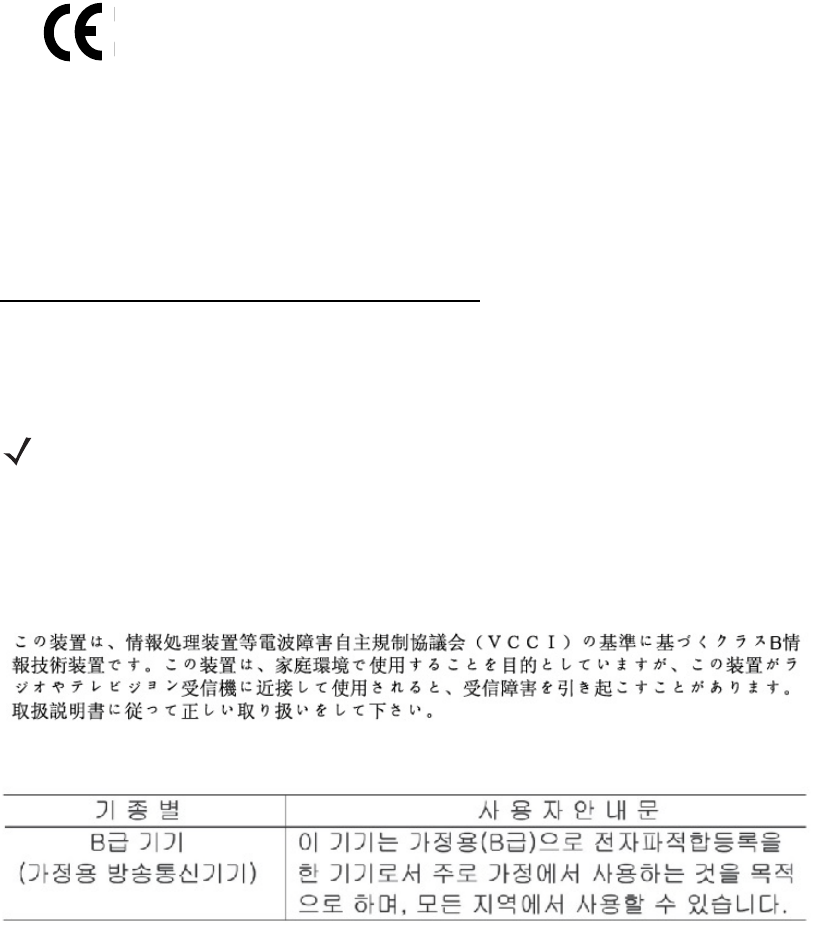
22 LI3678 Quick Start Guide
The use of 5 GHz WLAN's, for use in the US, have the following restrictions
Radio Frequency Interference Requirements- Canada
CAN ICES-3 (B)/NMB-3(B)
Radio Transmitters
This device complies with Industry Canada's licence-exempt RSSs. Operation is subject to the following two
conditions:
(1) This device may not cause interference; and (2) This device must accept any interference, including interference
that may cause undesired operation of the device.
Cet appareil est conforme exempts de licence le flux RSS de Industrie Canada. Son fonctionnement est soumis aux
deux conditions suivantes:
(1) Ce dispositif ne peut causer des interférences; et (2) Cet appareil doit accepter toute interférence, y compris les
interférences qui peuvent causer un mauvais fonctionnement de l'appareil.
Marking and European Economic Area (EEA)
Bluetooth® Wireless Technology for use through the EEA has the following restrictions:
•Maximum radiated transmit power of 100mW EIRP in the frequency range 2.400 -2.4835 GHz.
Statement of Compliance
Zebra hereby declares that this device is in compliance with the essential requirements and other relevant provisions of
Directive 1999/5/EC and 2011/65/EU. A Declaration of Conformity may be obtained from http://www.zebra.com/doc.
Other Countries
Brazil (UNWANTED EMISSIONS - ALL PRODUCTS)
Regulatory declarations for LI3678 - BRAZIL
For more information consult the website www.anatel.gov.br
Declarações Regulamentares para LI-3678 - Brazil
Para maiores informações sobre ANATEL consulte o site: www.anatel.gov.br
Japan (VCCI) - Voluntary Control Council for Interference
Class B ITE
Korea Warning Statement for Class B ITE
NOTE A marca de certificação se aplica ao Transceptor, modelo LI-3678. Este equipamento opera em caráter
secundário, isto é, não tem direito a proteção contra interferência prejudicial, mesmo de estações do
mesmo tipo, e não pode causar interferência a sistemas operando em caráter primário.
Draft 1_Not for Distribution
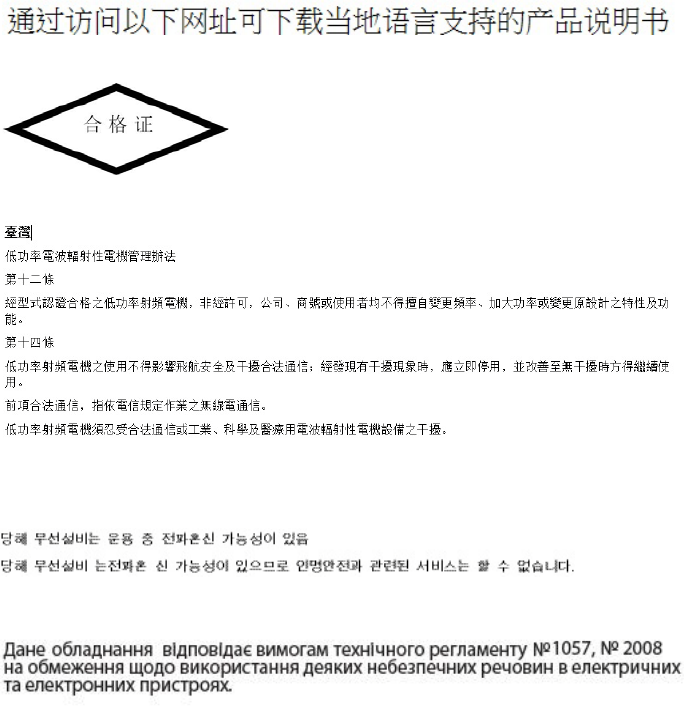
Chile
Este equipo cumple con la Resolución No 403 de 2008, de la Subsecretaria de telecomunicaciones, relativa a
radiaciones electromagnéticas.
China
http://www.zebra.com/contact
Taiwan
South Korea
For a radio equipment using 2400~2483.5MHz or 5725~5825MHz, the following two expression should be displayed:
Ukraine
Thailand
.
Draft 1_Not for Distribution

24 LI3678 Quick Start Guide
Waste Electrical and Electronic Equipment (WEEE)
Bulgarish: За клиенти от ЕС: След края на полезния им живот всички продукти трябва да се връщ ат на Zebra за рециклиране. За
информация относно връщането на продукти, моля отидете на адрес http://www.zebra.com/weee.
Čeština: Pro zákazníky z EU: Všechny produkty je nutné po skončení jejich životnosti vrátit společnosti Zebra k recyklaci. Informace o způsobu
vrácení produktu najdete na webové stránce: http://www.zebra.com/recycling/weee.
Dansk: Til kunder i EU: Alle produkter skal returneres til Zebra til recirkulering, når de er udtjent. Læs oplysningerne om returnering af produkter på:
http://www.zebra.com/recycling/weee.
Deutsch: Für Kunden innerhalb der EU: Alle Produkte müssen am Ende ihrer Lebensdauer zum Recycling an Zebra zurückgesandt werden.
Informationen zur Rücksendung von Produkten finden Sie unter http://www.zebra.com/recycling/weee.
Ελληνικά: Για πελάτες στην Ε.Ε.: Όλα τα προϊόντα, στο τέλος της διάρκειας ζωής τους, πρέπει να επιστρ έφονται στην Zebra για ανακύκλωση. Για
περισσότερες πληροφορίες σχετικά με την επιστροφή ενός προϊόντος, επισκεφθείτε τη διεύθυνση http://www.zebra.com/recycling/weee στο
Διαδίκτυο.
English: For EU Customers: All products at the end of their life must be returned to Zebra for recycling. For information on how to return product,
please go to: http://www.zebra.com/recycling/weee.
Español: Para clientes en la Unión Europea: todos los productos deberán entregarse a Zebra al final de su ciclo de vida para que sean reciclados.
Si desea más información sobre cómo devolver un producto, visite: http://www.zebra.com/recycling/weee.
Eesti: EL klientidele: kõik tooted tuleb nende eluea lõppedes tagastada taaskasutamise eesmärgil Zebra'ile. Lisainformatsiooni saamiseks toote
tagastamise kohta külastage palun aadressi: http://www.zebra.com/recycling/weee.
Suomi: Asiakkaat Euroopan unionin alueella: Kaikki tuotteet on palautettava kierrätettäväksi Zebra-yhtiöön, kun tuotetta ei enää käytetä. Lisätietoja
tuotteen palauttamisesta on osoitteessa http://www.zebra.com/recycling/weee.
Français : Clients de l'Union Européenne : Tous les produits en fin de cycle de vie doivent être retournés à Zebra pour recyclage. Pour de plus
amples informations sur le retour de produits, consultez : http://www.zebra.com/recycling/weee.
Magyar: Az EU-ban vásárlóknak: Minden tönkrement terméket a Zebra vállalathoz kell eljuttatni újrahasznosítás céljából. A termék
visszajuttatásának módjával kapcsolatos tudnivalókért látogasson el a http://www.zebra.com/recycling/weee.
Italiano: per i clienti dell'UE: tutti i prodotti che sono giunti al termine del rispettivo ciclo di vita devono essere restituiti a Zebra al fine di consentirne il
riciclaggio. Per informazioni sulle modalità di restituzione, visitare il seguente sito Web:
http://www.zebra.com/recycling/weee.
Lietuvių: ES vartotojams: visi gaminiai, pasibaigus jų eksploatacijos laikui, turi būti grąžinti utilizuoti į kompaniją „Zebra“. Daugiau informacijos, kaip
grąžinti gaminį, rasite: http://www.zebra.com/recycling/weee.
Latviešu: ES klientiem: visi produkti pēc to kalpošanas mūža beigām ir jānogādā atpakaļ Zebra otrreizējai pārstrādei. Lai iegūtu informāciju par
produktu nogādāšanu Zebra, lūdzu, skatiet: http://www.zebra.com/recycling/weee.
Malti: Għal klijenti fl-UE: il-prodotti kollha li jkunu waslu fl-aħħar tal-ħajja ta' l-użu tagħhom, iridu jiġu rritornati għand Zebra għar-riċiklaġġ. Għal aktar
tagħrif dwar kif għandek tirritorna l-prodott, jekk jogħġbok żur: http://www.zebra.com/recycling/weee.
Nederlands: Voor klanten in de EU: alle producten dienen aan het einde van hun levensduur naar Zebra te worden teruggezonden voor recycling.
Raadpleeg http://www.zebra.com/recycling/weee voor meer informatie over het terugzenden van producten.
Polski: Klienci z obszaru Unii Europejskiej: Produkty wycofane z eksploatacji naleźy zwrócić do firmy Zebra w celu ich utylizacji. Informacje na temat zwrotu produktów
znajdują się na stronie internetowej http://www.zebra.com/recycling/weee.
Português: Para clientes da UE: todos os produtos no fim de vida devem ser devolvidos à Zebra para reciclagem. Para obter informações sobre
como devolver o produto, visite: http://www.zebra.com/recycling/weee.
Românesc: Pentru clienţii din UE: Toate produsele, la sfârşitul duratei lor de funcţionare, trebuie returnate la Zebra pentru reciclare. Pentru informaţii
despre returnarea produsului, accesaţi: http://www.zebra.com/recycling/weee.
Slovenčina: Pre zákazníkov z krajín EU: Všetky výrobky musia byť po uplynutí doby ich životnosti vrátené spoločnosti Zebra na recykláciu. Bližšie
informácie o vrátení výrobkov nájdete na: http://www.zebra.com/recycling/weee.
Slovenski: Za kupce v EU: vsi izdelki se morajo po poteku življenjske dobe vrniti podjetju Zebra za reciklažo. Za informacije o vračilu izdelka
obiščite:http://www.zebra.com/recycling/weee.
Svenska: För kunder inom EU: Alla produkter som uppnått sin livslängd måste returneras till Zebra för återvinning. Information om hur du returnerar
produkten finns på http://www.zebra.com/recycling/weee.
Türkçe: AB Müşterileri için: Kullanım süresi dolan tüm ürünler geri dönüştürme için Zebra'ya iade edilmelidir. Ürünlerin nasıl iade edileceği hakkında
bilgi için lütfen şu adresi ziyaret edin: http://www.zebra.com/recycling/weee.
TURKISH WEEE Statement of Compliance
Draft 1_Not for Distribution
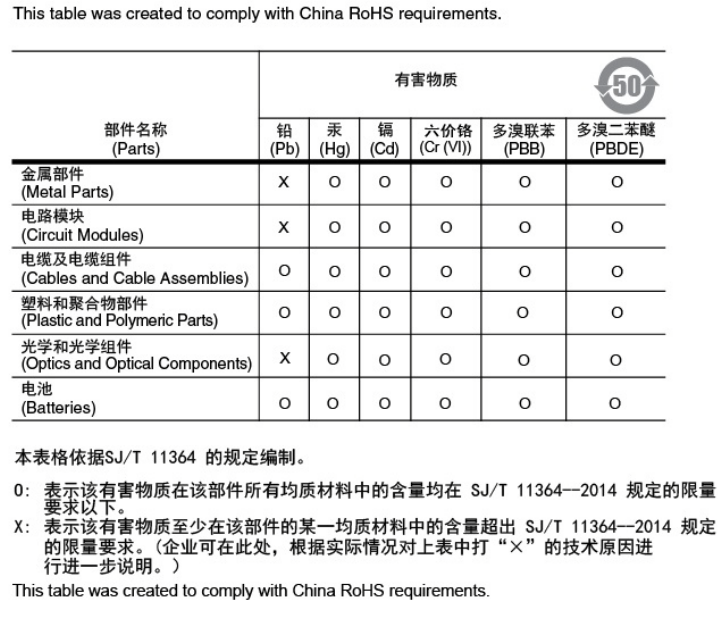
LI3678 Quick Start Guide 25
China RoHS
Draft 1_Not for Distribution
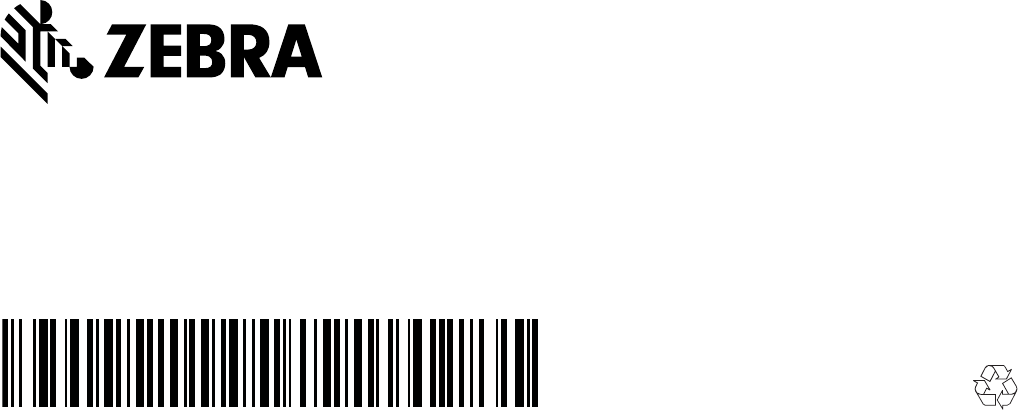
26 LI3678 Quick Start Guide
MN002651A01EN Revision Draft 1- December 2015
Zebra Technologies Corporation
Lincolnshire, IL U.S.A.
http://www.zebra.com
Zebra and the stylized Zebra head are trademarks of ZIH Corp., registered in many jurisdictions
worldwide. All other trademarks are the property of their respective owners.
©2015 ZIH Corp and/or its affiliates. All rights reserved.
Draft 1_Not for Distribution